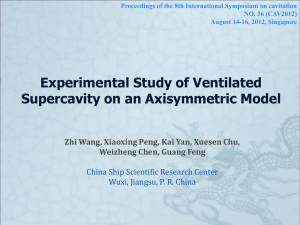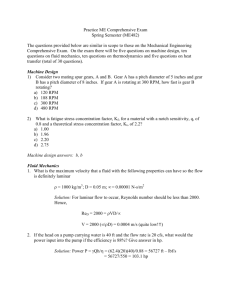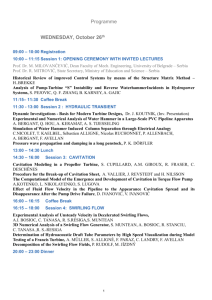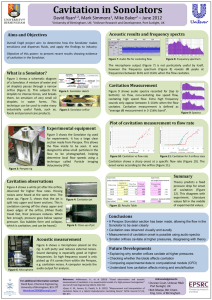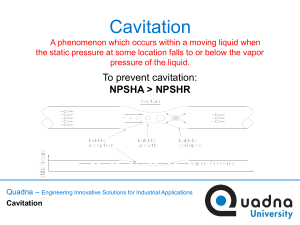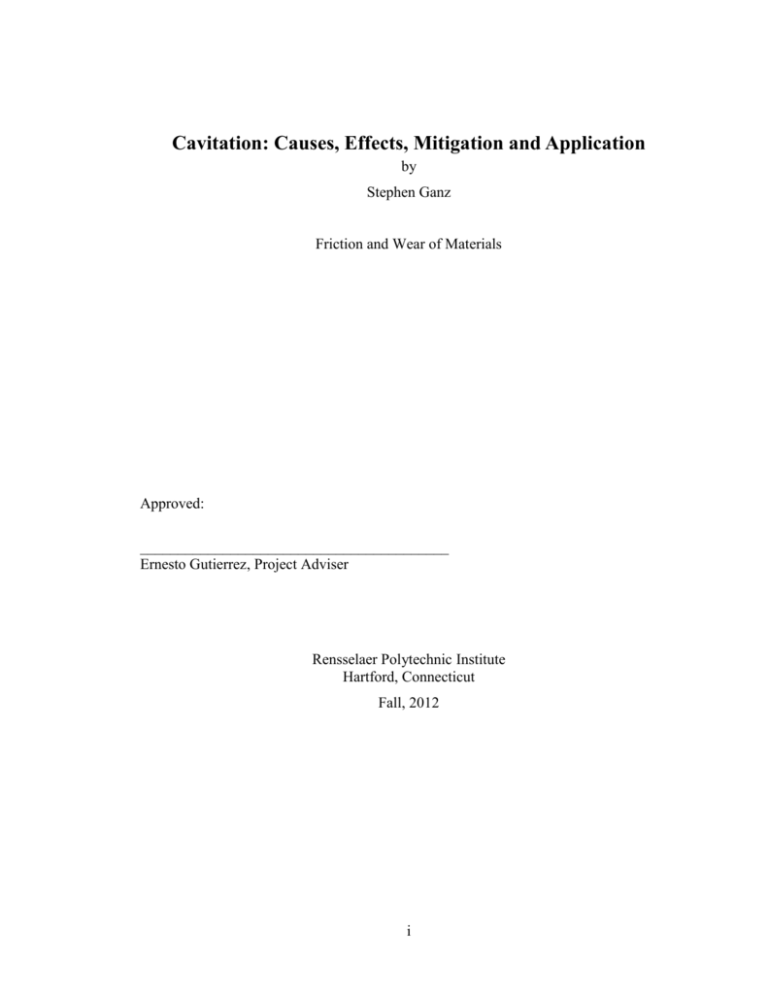
Cavitation: Causes, Effects, Mitigation and Application
by
Stephen Ganz
Friction and Wear of Materials
Approved:
_________________________________________
Ernesto Gutierrez, Project Adviser
Rensselaer Polytechnic Institute
Hartford, Connecticut
Fall, 2012
i
© Copyright 2012
by
Stephen Ganz
All Rights Reserved
ii
CONTENTS
Cavitation ............................................................................................................................ i
LIST OF FIGURES .......................................................................................................... iv
TERMINOLOGY / LIST OF SYMBOLS / ACRONYMNS ............................................ v
ABSTRACT ..................................................................................................................... vi
1. Introduction.................................................................................................................. 1
1.1
Cavitation and the Mechanism that causes it ..................................................... 1
2. Cavitation in Applications ........................................................................................... 3
2.1
Cavitation in Marine Applications ..................................................................... 3
2.2
Cavitation in Automotive Applications ............................................................. 5
2.3
Cavitation in Pump Applications ....................................................................... 7
3. Cavitation Mitigation ................................................................................................... 8
4. Practical use of Cavitation ........................................................................................... 9
5. Conclusions................................................................................................................ 11
6. References.................................................................................................................. 12
iii
LIST OF FIGURES
Figure 1: Collapsing phase of a vapor bubble ................................................................. 1
Figure 2: Actual stages of a collapsing vapor bubble ...................................................... 2
Figure 3: Cavitation of hydrofoils and propellers............................................................ 3
Figure 4: Cavitation’s effect on lift and drag................................................................... 4
Figure 5: Propellers exhibiting cavitation damage .......................................................... 4
Figure 6: Cavitation in Engines ....................................................................................... 5
Figure 7: A cavitation eroded water pump cover from a 6.4L Ford Power Stroke diesel
engine ............................................................................................................................... 6
Figure 8: Cavitation damage in some pumps .................................................................. 7
Figure 9: Figure illustrating the principle of supercavitation .......................................... 9
iv
TERMINOLOGY / LIST OF SYMBOLS / ACRONYMNS
σ – Cavitation Number
Pa – Ambient Pressure
Pc – Cavity Pressure
ρ – Density
U – Fluid velocity
v
ABSTRACT
This project will examine cavitation, the mechanism that causes it, it’s damaging effect
on mechanical components in the marine and automobile industry, cavitation mitigation
and the practical applications of cavitation. Cavitation is a phenomenon that occurs
when bubbles form in a liquid due to a pressure drop, then violently collapse. This is
usually a consequence of fluids moving at high velocity when the local pressure falls
below vapor pressure allowing small amounts of liquid to vaporize. When the bubble reenters a region of high pressure, the bubble then collapses violently with enough energy
and force to erode metal.
Damage from a single bubble collapse is almost
immeasurable; it is the constant accumulation of damage over long periods of time that
causes significant removal of material, hence “cavitation erosion”. The highly focused
jets of liquid from the collapsing bubbles blast away micro-amounts of material which
eventually gives the surface a pitted appearance. This is commonly a problem for
mechanical components such as hydrofoils, propellers, automobile engines and
centrifugal pumps in working environments of in the marine, automotive and industrial
applications where liquid velocity is high and pressure head is low.
However, cavitation is not totally unavoidable as there are several ways to suppress it;
this primarily includes increasing pressure head, lowering the liquid’s temperature, good
design practices or all of the above.
Nor is cavitation always an undesirable
phenomenon. It has practical application in the marine industry as a means of reducing
drag, enabling objects and hydrofoils designed to function in supercavitating flows can
achieve extremely high speeds. The biomedical industry is investigating its application
in the treatment of certain diseases such as cancer. Even some forms of marine life use
cavitation to catch their prey.
vi
1. Introduction
1.1 Cavitation and the Mechanism that causes it
Cavitation is defined as the process of formation of the vapor phase of a liquid when it is
subjected to reduced pressures at constant ambient temperature [1]. Although other
factors such as changes in temperature, turbulence and velocity play a role, the change of
liquid to vapor is the same. When bubbles then enter a region of higher pressure or lower
temperature, they collapse violently producing a jet of liquid that creates shockwave
upon impact with a surface enough force to erode metal [2]. Although the collapse is
generally a low-energy event, it is highly localized. The figure below illustrates the
collapsing phase and resulting jet, referred to as the re-entrant micro jet:
Figure 1: Collapsing phase of a vapor bubble [1]
As previously mentioned the mechanism responsible for initiating cavitation is a
pressure drop causing the water to undergo a phase change from liquid to vapor.
However, this is unlike a boiling pot of water that is common to most of us. When water
boils under normal conditions, say 212°F at 1 atmosphere, it undergoes a phase change
from liquid to vapor and increases in volume over 1000x. The vapor bubble rises to the
surface and bursts. The pressure in the bubble is low (approx. 1 atm) and the circular
area is relatively large. Now if water was to change from liquid to vapor due to a
pressure drop at an ambient temperature such as 68°F it increases to over 50,000x its
original volume. Almost the exact opposite happens to a collapsing bubble due to
cavitation compared to a bubble bursting at the surface of a pot of boiling water. When
this bubble begins to collapse the pressure may be up to 10,000 atmospheres. Also, the
bubble also tends not to collapse uniformly in all directions and as a result, a powerful
1
jet of liquid is formed as it rushes in to fill the void once occupied by the bubble [2].
Unfortunately, the direction of the jet is most likely to be directed at the surface of the
device initiating the process, such as the blades of a pump.
Figure 2: Actual stages of a collapsing vapor bubble. Note how the bubble
collapses unevenly and the formation of the jet [2].
A single cavitation event produces little if any noticeable damage. It is the accumulation
of damage from multiple events (thousands, millions, billions…) over time that causes
noticeable damage known as pitting, hence the phrase “cavitation erosion”.
It is
sometimes referred to as cavitation corrosion, but this is inaccurate. Corrosion is due to
chemical reactions and erosion is the physical removal of material by an external force,
but cavitation can help initiate corrosion by exposing surfaces. Therefore, corrosion due
to cavitation is a secondary mechanism.
The chances of cavitation occurring can be calculated based on the ambient pressure
(Pa), cavity pressure (Pc), mass density (ρ) and velocity (U) of the liquid. Similar to the
Euler equation, the equation for cavitation number is:
Pa Pc
1 U2
2
Equation for cavitation number [1].
For a specific liquid, the value calculated by the cavitation number at which cavitation
occurs is called the critical cavitation number. Above this value cavitation does not
occur [1].
2
2. Cavitation in Applications
As previously stated, the most common mechanism to cause cavitation is local regions
of low pressure. An environment where this is most likely to happen is in marine
applications, industrial pumps and automotive engines, specifically diesel engines with
removable liners.
2.1 Cavitation in Marine Applications
In marine applications such as hydrofoils, water flows over the foil in the same way air
does over an airplane wing. The specially designed shape of the foil causes the fluid
traveling over it to accelerate and as a result, create a local region of low pressure. This
drop of pressure allows the water to boil into small bubbles which collapse as they reenter a region of higher pressure as they approach the trailing edge of the foil. This is
basically the same mechanism that causes cavitation to occur on a propeller. The
propeller moves at very high velocity causing liquid to vaporize into bubbles at the
outermost edges and the core of tip vortices [1].
Figure 3: Cavitation of hydrofoils and propellers. The picture on the left shows the
formation of bubbles at the top surface of the hydrofoil where pressure is lowest.
When cavitation occurs beyond the trailing edge it is said to be “supercavitating”.
The figure on the right shows cavitation bubbles forming at the edges of a marine
propeller in a water tunnel. Note that the bubbles form at the edge and in trailing
vortices where velocity is highest.
In hydrofoils and propellers, cavitation has several negative consequences. Primarily,
cavitation causes erosion at a rate that accelerates as the surface becomes more and more
3
eroded by the cavitation action. As the surface becomes rougher due to erosion it
increases turbulence, increasing surface area and forming crevices or “pits” that can
serve as nucleation sites for cavitation to occur [1]. Secondly, the formation of bubbles
causes these devices to fall out of their efficiency range reducing the amount of lift or
thrust.
Figure 4: Cavitation’s effect on lift and
drag. The figure on the left illustrates the
effect of cavitation on lift on a hydrofoil, and
once cavitation occurs, efficiency suffers
significantly [1].
Thirdly, the shockwave produced by the accelerated jet of fluid emits sound – an
extremely undesirable consequence if the application needs to have minimal sound
signature (i.e. submarines and other naval ships).
Figure 5: Propellers exhibiting cavitation damage.
4
2.2 Cavitation in Automotive Applications
Cavitation in automotive applications is caused by the same basic mechanism as in
marine applications – local areas of low pressure. But these systems are often more
complex by design inherently creating more areas where cavitation can occur (visualize
the coolant passages in an engine block). This is due to turbulence caused by sharp
turns, changes in orifice size, larger number of nucleation sites or vapor contamination.
The rapid change in fluid pressure due to a change in orifice size is known as the Venturi
effect [3].
Other causes that are unique to diesel engines are prolonged engine operation and
cylinder wall/liner vibration. The walls of the combustion chamber can vibrate at a very
high frequency due to piston slap to the point where the alternating high/low pressure
waves cause the coolant in contact with or close proximity to the surface to cavitate over
and over again [4]. This is more of a problem in diesel engines equipped with cast iron
replaceable cylinder liners, as these liners can vibrate against coolant during operation
and/or allow combustion gases to contaminate the cooling system. Once the surface is
eroded, erosion and corrosion (rust) occurs at an accelerated rate which can fully
penetrate the liner wall. Fleetguard reports that in tests where plain water was used as
coolant, penetration can occur in as little as 500 hours of operation [4].
Figure 6: Cavitation in Engines. The picture on the left illustrates liner pitting due to
cavitation [4]. On the right, a Caterpillar diesel engine cylinder liner exhibiting the
effects of cavitation erosion [3].
5
In other cases of some diesel engines, in this case the 6.4 L Ford Power Stroke diesel
manufactured by Navistar International Corporation for use in 2008-2010 F-250, 350,
450 and 550’s Ford trucks. Cavitation is also believed to be the result of improper
coolant levels and/or lack of maintenance. Coolant that is too low creates pockets of air
that can affect system pressure. Cavitation can also be the result from lower axle ratios,
thus causing higher engine rpms at highway speeds, that is why this is more common in
trucks in F-450 550’s with 4.30, 4.88 and 5.38 rear end gears [5]. The lowest ratio
offered is 4.10 and F-350 is 4.30. The higher engine rpms drive the water pump faster
increasing the risk of cavitation of the water pump cover. If the cover is breached
coolant can contaminate the oil system and vice-versa. A redesigned front cover for the
water pump was issued to mitigate cavitation.
Figure 7: A cavitation eroded water
pump cover from a 6.4L Ford Power
Stroke diesel engine [5].
Aside from diesel engines, gas engines have been known to suffer the ill effects of
cavitation as engines become smaller. A poorly designed, smaller coolant system must
flow at higher velocities as compensation to achieve the same performance of a larger
one.
6
2.3 Cavitation in Pump Applications
Centrifugal pumps are often victims of cavitation if the local pressure falls below the
vapor pressure of a specific liquid. The pressure of the pump in feet of water is known
as the Net Pressure Suction Head available (NPSHa) and this is the sum of atmospheric
pressure (Ha), vertical distance from water surface to pump centerline (+/- Hz), friction
in the pump (Hf), pump flow velocity (Hv) and vapor pressure of the water at ambient
pressure (Hvp) [2].
NPSHa = Ha + Hz – Hf + Hv – Hvp
Equation for NPSHa [2].
If the NPSHa falls below the Net Pressure Suction Head required (NPSHr) damaging
cavitation will occur, this is called suction cavitation. It can be caused by design,
specific operating conditions or obstructions in the system.
NPSHr is a value
determined by the manufacturer through testing. The manufacturer may also determine
Net Pressure Suction Head inception (NPSHi), this is the pressure required by the pump
to suppress all cavitation. In between NPSHi and NPSHr non-damaging cavitation can
occur [2].
Figure 8: Cavitation damage in some pumps. Note the tag team effect
caused by erosion and corrosion.
Other ways a pump can experience cavitation is through recirculation and excessive
discharge velocities [2]. In recirculation, the relative velocity of two opposed flows of
liquid is very high, thus causing cavitation.
7
3. Cavitation Mitigation
Cavitation can be detected and mitigated since the mechanisms behind cavitation are
well understood and because cavitation generates a shock wave resulting in audible
sounds and mechanical vibrations. This sound is usually observed as “crackling” or
popping [2]. The simplest way to reduce cavitation in a pump system is by increasing
pressure at the head. This can be accomplished by increasing the vertical distance
between the reservoir tank and the pump, by either raising the tank or lowering the
pump. One can also raise the level of liquid in the tank or pressurize the tank. Good
design practices should be utilized to reduce frictional piping losses and reduce
turbulence. This can be achieved by: maintaining 10 diameters of pipe between the
suction head and the first elbow, minimizing the amount of fittings, properly sizing
pumps for the given diameter of pipe [6]. Lowering the temperature of the liquid with
heat shielding or utilizing dedicated systems to reduce temperatures helps as well.
All engine manufacturers will agree that maintenance is key to identifying and reducing
the chances of engine cavitation damage occurring. Inspecting for obstructions in the
system and checking proper coolant levels isn’t just recommended, it’s necessary.
Commercially available Supplemental Coolant Additives (SCA’s) are recommended for
use in diesel engines with liners to control cavitation damage. These chemicals such as
Fleetguard ES Coolant™, work by chemically reacting to rust and forming a self-healing
microscopic layer of FE3O5. FE3O5 is very hard and resists the collapsing bubbles [4].
In the case of hydrofoils and propellers, the working environment is less controllable.
The previously mentioned methods of increasing head pressure or water temperature are
not feasible. These components often must be designed to operate under cavitation
conditions and the benefits of this can be exceptional, this is discussed in the following
section.
8
4. Practical use of Cavitation
Cavitation is not entirely negative despite the fact it is generally detrimental to
mechanical components in most applications. There are, however, several practical uses
of cavitation. The biomedical field uses ultrasonic cavitation to destroy kidney stones
and aid in the treatments of some forms of cancer [7].
High-Intensity Focused
Ultrasound is an alternative to more traditional invasive treatments, as some of the sound
waves are absorbed by tissues heat is generated.
Research is being conducted to
investigate how to direct and focus cavitation to aid in the destruction of diseased tissues
[8].
Cavitation is also used in industry for homogenization such as processing milk. Fat
would naturally collect at the upper surface milk, the homogenization process evenly
disperses fat by breaking it down thus creating a uniform product [7]. Cavitation is also
being researched for use in water purification. Dynaflow, Inc. has developed a product
called DynaJets that uses cavitation to detroy harmful compunds [9].
Supercavitation is being researched by the marine industry as a way of increasing
maximum velocity a solid body can travel through a medium. Supercavitation occurs
when there is such a large amount of cavitating bubbles that the object is almost
completely surrounded by vapor. This greatly reduces the amount of drag by displacing
the water around the object. It is currently used to increase the speed of torpedos and
very fast hydrofoils [10].
Figure 9: Figure illustrating the principle of supercavitation. The goal in
the practical application of this phenomenon is to reduce drag.
9
Some species of marine life use cavitation as a way of catching prey. Specifically, the
mantis shrimp and pistol shrimp have specially developed claws that can strike fast
enough to induce cavitation. The benefits of this evolutionary ability are significant in
that even if the strike of the claw misses, the shock wave will stun or may be enough to
kill the prey by itself. They accelerate their claw as fast as a .22 caliber bullet, therefore
making them the fastest strikers in the animal kingdom [11][12].
10
5. Conclusions
Cavitation is a naturally occurring phenomenon in which an external force inducing a
pressure drop causes liquid to vaporize, and then the vapor bubbles violently collapse.
The incredibly fast, uneven collapse of the vapor bubble produces a high velocity jet of
liquid that can damage surfaces because this low energy event is so highly focused. The
shock wave also produces unwanted sound and vibration. Individually, a single collapse
of a vapor bubble produces virtually no damage. But because cavitation is generated
constantly in high velocity flows their damage compounds over time and can be seen as
pitting. The rate of erosion of the surface is accelerated over time as its deteriorated
surface creates more turbulence thus creating more cavitation. This is especially bad for
metals such as iron and steels where surface degradation is worsened by a tag-team
effect of corrosion. This makes cavitation a unique engineering problem.
Generally, in most applications cavitation can be reduced or eliminated entirely by
increasing system working pressure, controlling temperature and maintaining proper
concentrations of cavitation mitigating additives.
It also has many practical applications in the marine industry, biomedical field and
nature.
Supercavitating flows allow vessels to travel faster than ever thought
imaginable. Researchers in medicine are developing ways to harnesses the destructive
power of cavitation to physically destroy diseases and some species of shrimp use
cavitation as a tool for hunting and communication. Cavitation can even be used to
purify water by using its destructive power to breakdown harmful substances into nontoxic compounds.
11
6. References
1. Eisenberg, Phillip “Cavitation”. Hydronautics Incorporated.
<http://web.mit.edu/hml/ncfmf/16CAV.pdf>
2. Evans, Joe PhD. “Cavitation – A largely Misunderstood Phenomenon”. August
2005.
<http://www.pumped101.com/cavitation.pdf>
3. Ford Doctors Diesel Technician Society, “Cavitation Erosion”. November 30, 2009.
<http://www.forddoctorsdts.com/articles/article-09-02.php>
4. Fleetguard Bulletin No.: 3.300.963A “Diesel Engine Liner Pitting”
<http://www.fleetguard.com/pdfs/product_lit/asia_pacific_brochures/3300963A.pdf>
5.
Ford Motor Company, “2010 F-350/F-450/F-550 F-350/F-450/F-550 Super Duty®
Chassis Cabs Technical Specifications”. June 2009.
<https://www.fleet.ford.com/truckbbas/non-html/2010/10_F-350-550Chassis.pdf>
6. McNally, mcnallyinstitute.com, “Cavitation 1-3”. August 18, 2012.
<http://www.mcnallyinstitute.com/01-html/1-3.html>
7. Various Authors, wikipedia.com, “Cavitation”.
<http://en.wikipedia.org/wiki/Cavitation>
8. Sinden, D., “Modelling Cavitation in Liver Tissue Under High-Intensity Focused
Ultrasound”. March 11, 2011.
<http://www.ucl.ac.uk/~ucesdsi/birm_4.pdf>
9. Dynaflow, Inc. “DynaJets”.
<http://www.dynaflow-inc.com/Products/Brochures/Oxidation_Trifolded.pdf>
12
10. Various Authors, wikipedia.com, “Supercavitation”.
<http://en.wikipedia.org/wiki/Supercavitation>
11. Aquaticcommunity.com “Mantis Shrimp”. August 2004.
http://www.aquaticcommunity.com/Mantis-shrimp/
12. “Deadly strike mechanism of a mantis shrimp”. Nature Publishing Group, Nature
Volume 248. April 22, 2004.
<http://www.bio.umass.edu/biology/pateklab/sites/www.bio.umass.edu.biology.pate
klab/files/Pateketal2004Nature.pdf>
13


